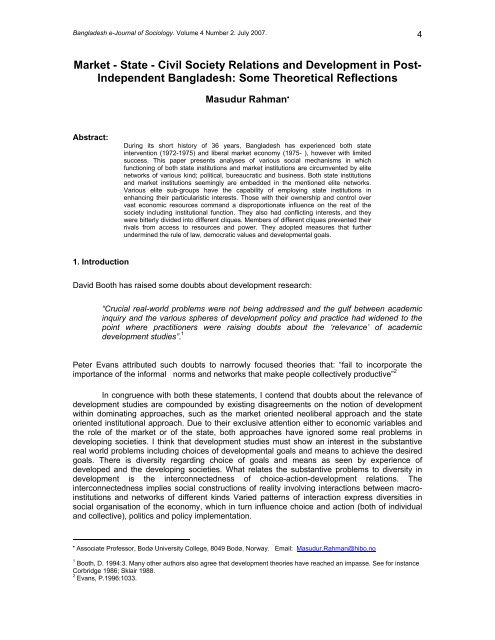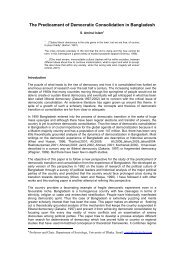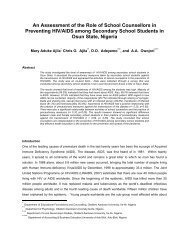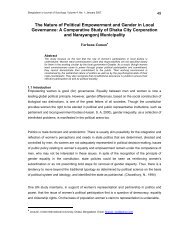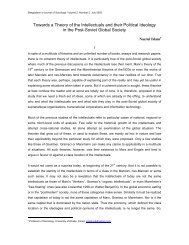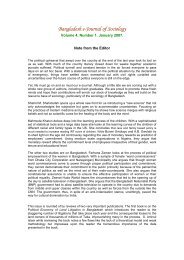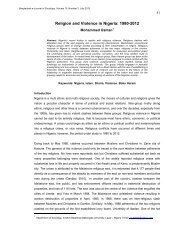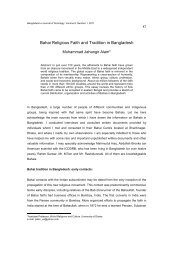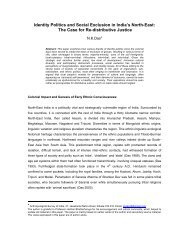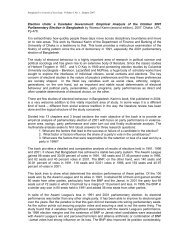Masudur Rahman - Bangladeshsociology.org
Masudur Rahman - Bangladeshsociology.org
Masudur Rahman - Bangladeshsociology.org
Create successful ePaper yourself
Turn your PDF publications into a flip-book with our unique Google optimized e-Paper software.
Bangladesh e-Journal of Sociology. Volume 4 Number 2. July 2007. 93.2. Networks circumventing the state.The institutionalists focus on an active state in correcting ‘market failure’ and argue that in thosecountries, which tried to ’catch up’ with the Western industrialised countries, it was the structureand functioning of the state, which explain both the successes and the failures of these efforts. 40They claim that development, through industrialisation, never proceeds independently of theconcrete institutional and historical context. Particular industrial pathways are embedded in localsocio-cultural and socio-political contexts. They study how market mechanisms operate, howparticular processes of industrial development are embedded in the particular character of thestate, how the prevailing internal <strong>org</strong>anisation (of business firms, banks etc.,) affect the patternsof industrial development as it has impacts on choices and the implementation of policies. 41Therefore, their policy prescription is to mobilise diverse social institutions including the market,community and the state in order to achieve developmental goals. The government must play aleading role in harmonising different strategies and in managing the process of development inways that stimulate participation of communities and market forces.There is however a disagreement among the institutionalists on whether it is the degreeor the kind of state intervention that is decisive for development.One school, 42 referring to the experience of the East Asian countries, maintains that therole played by state bureaucracy is crucial for development. The high-performing newlyindustrialised countries have achieved their high growth rates because the state governed themarkets in critical ways. Rather than leaving price formation to the market, these states havedeliberately distorted relative prices in order to alter the incentive structure with a further view toboosting strategically important industries.Development theorists within new institutional economics claim that the market is onlyone aspect of society and it has limited influence on the economy. Particularly in developingeconomies, where the market is not perfect, other social institutions are more important in<strong>org</strong>anising the economy 43 and have strong effects on the formation and functions of the market.On development, they suggest that development should be redefined as economic growth plusappropriate institutional changes, which facilitate further growth. They address the issues of howbusiness firms and banks are <strong>org</strong>anised, how to assess who should get loans and in what firmsinvestments are made.I agree with both these schools as regards their claims and emphasis on factors thatneed to be addressed. It requires addressing the questions of why and how institutions arebrought into existence. In agreement with sociological perception I claim, institutions must beregarded as historical process, as the result of gradual social creation, as ways of doing things,which by a process of ‘hardening’ and ‘thickening’ become patterns of action. 44One variety of institutionalism is based upon Polanyi’s notion of ‘embeddedness’. Polanyiclaimed that production, distribution and consumption of goods, trade and markets wereembedded in wider social, religious and political institutions in pre-industrial societies. Elaboratingon Polanyi, it can be argued that development study is about how different institutionalarrangements brought about, or failed to bring about, industrialised market societies. For Polanyi,economic activities result from human interaction with the social environment on which theirlivelihood depends. Development of modern (market) societies is a changed form of suchinteractions characterised by exchange. 45 The emergence of a (disembedded) market economyin the 19 th century, took place by means of deliberate state policies. Economic growth was seenas the foundation of state strength. Market domination was a by-product of state buildingstrategies. The dominant position of the market was possible only through commodification of40There are many theorists within the institutional approach. In the present discussion I will refer mainly to Polanyi, andscholars within New Institutional Economics such as Arrow, Davis, Debrew, Plateu, North etc.41Pattern refers to varieties in the configuration of leading industries, leading agents (state vs. Private, local vs. foreignetc.), leading orientation (e.g. export oriented vs. domestic market oriented, forward linkage and backward linkage) andleading pattern of distribution. See Senghaas (1988) for details on patterns of industrialisation.42Theories on developmental state, the revisionists and the statists. The major proponents are Amsden and Wade.43Jerome Davis (1993) makes an account of institutional factors in developing countries.44As claimed by Berger and Luckmann 1966.45Poanyi’s notion of three modes of transaction is discussed in chapter 2, section 2.2.
Bangladesh e-Journal of Sociology. Volume 4 Number 2. July 2007. 10land, labour and money. However, commodification appeared to be a weakness of marketsocieties because of its destabilising effects. Hence, the effort to protect society from thedevastating impacts of the market involved state intervention, for example through redistributionin the emerging welfare states. The market was institutionally arranged, both as it was (partly)disembedded from, and reembedded in non-market institutional arrangements. 46Polanyi explained how state was involved in the development of market societies in earlyindustrialising Western Europe. Later studies suggest that state intervention frequently serves thepurposes of particularistic interest groups by allowing them their privileged access to materialresources and thus creates surplus-extracting state elites in most developing societies. 47 Unlikethe process described by Polanyi, state power has been used to promote non-market forms ofcapital accumulation. There is clear evidence of how state intervention leads to ‘rent-seeking’activities and unproductive income-earning economic activities result from monopolies created bystate regulation. 48 The government is not an independent actor 49 rather it is used as a vehicle tosecure the interests of the privileged classes. The state itself contributes to the process ofdifferentiation. 50 Interest groups are allied with each other to shape public policies in manydeveloping countries. 51 The fate of the state-owned industries in post-independent Bangladeshcan be cited as good evidence.Right after independence of Bangladesh in December 1971 all major industries andenterprises came under state ownership. The party in power used state industries to fosterinterest groups by supplying public sector goods and services to party members. Closeassociates of the political leaders and the state bureaucracy acquired supply contracts to thestate owned industries. They offered supplies of machinery, spare parts and raw materials atmuch higher rates than the market price. The state owned enterprises sold their products todifferent distributors below cost. Such a situation naturally limited the capacity of the state ownedindustries. 52 Furthermore, there were two major factors that contributed to the state’s limitedcapacity.First, the major state-owned industries were producing mass consumption goods. Due toshortage of state funds, the management personnel of the state owned enterprises were paid inkind instead of salary. They consumed what they needed and sold the excess products in themarket. Furthermore, close associates of political leaders worked as distributors of the stateownedentreprises. Both the management and the distributors wanted to see prices raised.Second, the state-owned enterprises were subsidised by the state. Loans and credits tothese enterprises were diverted to the personal consumption of the management in alliance withpolitical leaders.In such circumstances, generation of surplus in the state-owned industries was adverselyaffected and resource utilisation could not be optimised.The discussion in section 3.1 took the issue of how the market is enmeshed in the elite’spersonal ties. This section discussed the issue of the state’s relation to the elites that limited itscapacity in pursuing developmental goals. Apparently, to use Evans’ word, the elites have theirfeet planted firmly in both the state and the market. 53 Thus the question of autonomy of the state 54and the market comes to the fore, not the analytical dichotomy between state and market.Autonomy requires the functioning of these institutions and their capacity to regulate social forcesincluding elites regarding the achievement of socially desired collective goals. The question is46Polanyi 1957:77-85.47See Elsenhans 1991; Moon & Prasad 1994.48Krueger 1974, Bauer 1984.49Almond 1965:183-214, Almond & Coleman 1960, Easton, 1957: 383-400, Stepan 1973: 47-65.50The case of Bangladesh, see f.eks. Sobhan 1992, Jansen 1992, and many African countries, see Medard J.F. 1996.51Platteau , 1993.52Ahmed, M. 1987:1253Evans 1996.54By autonomy of the state I mean that the state and state institutions should be allowed to function independent ofinterest groups or rent seeking groups.
Bangladesh e-Journal of Sociology. Volume 4 Number 2. July 2007. 11what are the necessary conditions for the achievement of collective goals? New institutionalistsaddress this question.3.3. Civil society: Networks and forms of social capital.The new institutionalists shifted their attention from the state as well as from the market to civilsociety. 55 They relate the notion of norms of reciprocity in civil society with the implementation ofdevelopment strategies.The approach was developed as an alternative both to the neo-liberal as well as to theinstitutional approaches. The basic idea is that informal norms and customs, conventions andstandard of operating practices structure the relationships between individuals, groups andinstitutions. It contends that trust and norms of reciprocity in civil society are the crucial issues,both for development and for the analysis of roles of the state and the market. 56 A variety withinthis school came to be known as ‘social capital’ theory. 57 Norms of reciprocity in network relationsand networks of repeated interactions that sustain trust are termed social capital. These normsoperate interpersonally, within cliques or communities, and obey a logic that is different from thatof the state or that of the market. 58Social capital theorists believe in ‘synergy effects’ of the state-civil society relations.Synergy implies making people collectively productive. It requires civic engagement or communityactions that facilitate the f<strong>org</strong>ing of norms of trust by using these norms and networks fordevelopment and for the function both of the state and the market. 59Not all social capital theorists believe in ‘synergy effects’. Ostrom thinks that effectivestate- civil society synergy cannot be taken for granted. 60 Some assume a ‘zero-sum’ relationshipbetween the state and the civil society. They believe that the expansion of formal norms of thestate and the market crowds out informal networks without generating synergy and new value ofeffective impersonal norms. 61The notion of synergy requires special attention because possible positive outcomes ofcivic engagement must be evaluated in terms of synergy. As I look at it, synergy depends onconnectedness i.e. the state’s relation with the civil society that provides an environment in whichcivic engagement is more likely to thrive. 62 Conversely, connectedness may preserve cronyism(due to privileges connected to elite network membership) without providing synergy. The imageof Bangladesh is illustrative. It displays both optimism (micro-credit programmes) andmalfunctioning elite-based of civil society (loan default etc).Empowering women through rotating credit can be cited as example of synergy effect ofjoint efforts of actors in the civil society. Loans are given to small groups of women, who are alsoprovided with know-how regarding how to make best use of loans. They invest loans in poultryfirm, fishing ponds, vegetable production etc. The returns are distributed amongst the members ofthe groups, and the groups are responsible for paying back the loans. The interest rate is asmuch as 16%, yet, loan default is less than 5%.These success stories can be contrasted with loan default (more than 80%) by differentelite sub-groups. Network ties (particularly political connections) are used as major means to getloans, to evade tax etc. Instead of generating ‘synergy’ such a relationship contributes to theprocess of concentration of resources in a few hands. It perpetuates corruption and competitionamong the elites regarding control over state institutions. The pervasive outcomes of suchcompetition are the use of force, struggle for inclusion into dominant networks and confrontationbetween the rival elites, which often take violent forms.55For instance Amsden, Wade (state centred) and Evans, Putnam (civil society oriented).56Putnam 1993, Moore 1996.57See for instance Putnam 1993 and 1995.58Evans 1996:1033.59See for instance Evans 1996, Putnam 1993.60Ostrom 1996.61See for instance Coleman 1990: 321.62This is congruent with Evans’ argument. Evans 1996:1034.
Bangladesh e-Journal of Sociology. Volume 4 Number 2. July 2007. 12The point I want to underline here is that the civil society is an arena where economic<strong>org</strong>anisations take shape, however, in varied forms, and hence, there are varied effects of civicengagement and social capital. Civic engagement can disrupt the power of particularistic interestgroups and make change possible. Social capital may have positive effects on development.Those societies, such as North Italy, Kerala etc., which have a good stock of social capital,achieved developmental goals. Conversely, political parties’ alliance with particular networks maydisrupt civic engagement aimed at developmental goals. My observation indicates a problem,which is ignored in some varieties of social capital theory, that social capital for one group is notnecessarily social capital for other groups. One relevant question is: The stock of social capital forwhom? Answering this question requires identifying different forms of social capital andrecognising their causal conjuncture. We need to examine the contexts in which people usesocial resources as social capital.Social capital theorists do recognise different forms of social capital. Putnamdistinguishes two forms of networks: horizontal and vertical. Horizontal networks bring togetherindividuals of equivalent status and vertical networks link individuals of unequal status inasymmetric relations of hierarchy and dependence. 63 For Putnam, civic engagement requireshorizontal interactions, which have the most beneficial effects for the society as a whole. Thiskind of strong civil society is also likely to translate into a strong and accountable state. Verticalnetworks contribute to solving collective problems to a lesser extent; individuals depend on oneanother, through hierarchic, uneven, terms.Coleman recognises obligations and expectations, informations potential, norms andeffective sanctioning, authority relations, appropriable social <strong>org</strong>anisation as social capital. 64Coleman also finds a commonality in values, which can be used as resources to realise theinterests of all.Ostrom and Ahn identified three broad forms of social capital: 1. trust and norms ofreciprocity, 2. networks, and 3. formal and informal rules. 65 Trust is the core concept that isaffected by networks and formal and informal rules, as well as by contextual factors. 66All these distinctions are important. Now the question is how to explain under what socialcircumstances a particular form of social capital is generated that result in synergy effects. I alsoraise the question whether a form of social capital for a particular group is also social capital forothers.There are cross-sectional linkages among different forms of social capital. 67 What I meanby causal conjuncture is such linkages i.e. various forms of interaction between individuals andnetworks and between networks and macro-institutions. Causal conjuncture may take differentforms in different social contexts and under shifting conditions. Contextual factors are important tounderstand why people put trust in networks or in institutions. I mentioned earlier, a criticalphenomenon in many developing societies is that the elites have the capacity to employ the stateto pursue particularistic interest, which underwrites the state’s capacity as well as peoples’ trust inthe state.Following Coleman and Putnam, a step further, one can say that a low level of trust in thestate is due to undermined systematic or generalised trust. Putnam claimed that there was moresocial capital in Northern Italy than in Southern Italy; whereas the horizontal networks enhancedco-operation in Northern Italy, vertical networks of clans or Mafia constrained co-operation in thesouth. Now the question is whether such vertical networks are social capital for the people inSouthern Italy?I refer again to causal conjuncture and contextual factors. Those may explain why socialcapital for one may not be social capital for other(s). Those also determine the possibility ofsynergy. One form of social capital may enhance co-operation and another may set constraints to63Putnam R. 1993:173.64Coleman 1990:304-33.65Ostrom and Ahn. 2001: 566Ostrom and Ahn. 2001.67Harris J. and De Renzio P. 1997:932-33.
Bangladesh e-Journal of Sociology. Volume 4 Number 2. July 2007. 13co-operation in attaining common goals on behalf of a large community. Weaker networks ofhorizontal relations are important in sustaining collective actions. 68 On the other hand,investments in networks generate horizontal connections among elites, as well as verticalrelations between them and their clients. The positive role of civil society, and social capital, indevelopment depends on internal dynamics of network structures.4. Concluding remarksThe discussion in this paper, on state-market-civil society relations and their impacts ondevelopment, directs our attention to interacting relationships between elite networks and thestate. Modern developed societies have undermined the role of more damaging elite networks.The success story of the newly industrialised countries also manifests the capacity of the state indefying unproductive elites and channelling surplus to productive investment. The state inBangladesh failed to perform these tasks. Predominant elite networks infiltrate the state andweaken its performance in its own right. This also explains the state’s failure in providing the rightframework for the market to function. The level of trust in the state and the market is the criticalissue. It does not follow from this that trust in personal contacts must be wiped off. The point israther to suggest that trust in personal contacts must complement trust in formal institutions.The postulation of the ‘zero-sum’ state-civil society relation is controversial. Civicengagement may enhance development and social mobilization. The positive effects of the statecivilsociety relationships can be observed. The cases of Northern Italy 69 , and Kerala in India 70could be pointed to as evidence. However, the term civil society may have a negative associationif it is tied to vested interests. The more extended evidence at hand points to the contrastingimages of Bangladesh, where the role of civil society is both positive and gloomy. Despite someachievements by civic engagements the stringer elite networks define policies and projects, whichremain out of reach of those for whom development is meant to bring some positive outcome.The conclusion of this paper is that it is fruitful to examine network structures and toconnect these to politico-economic relationships between the state and elite networks, in order tounfold the problems regarding capital accumulation. Networks of individuals interact with oneanother creating institutions, which then take on a life of their own, as we understand from Bergerand Luckmann. What is happening at the macro-level is connected to micro-level. Furtherunderstanding of networks shaping economic activities requires a discussion on economysocietyrelations. This is the subject matter of a forthcoming paper.68This is in agreement with Granovetter’s notion of the strength of weak ties. Conversely, as in Bangladesh, strong ties ofdense networks of relationship do not permit dissemination of information to the wider social arenas. There, limitednetworks of elites or cliques engage in mutual reciprocity at the expense of the larger social groups. This issue is takeninto consideration by Ostrom and Ahn. Ostrom E., and Ahn. T.K.: 2001.69Putnam 1993.70Heller 1996.
Bangladesh e-Journal of Sociology. Volume 4 Number 2. July 2007. 14ReferencesAlmond, G.A. and Coleman (eds.).: The Politics of developing Areas,Princeton University Press, 1960Amsden, A.H.: “The Quality of State Intervention in Late Industrialization”paper, EADI Conference, Berlin 15-18 September 1993Amsden, A.H.: “A Theory of Government Intervention in Late Industrialization” in Louise Putterman & DietrichRueschmeyer (eds.) State and market in Development: Synergy or Rivalry? pp.53-84, Boulder/London:Lyn Reider,1992Berger, P. L. & Luckmann T.: The Social Construction of Reality: A Treatise in the Sociology of Knowledge, Anchor, 1966Block F & Sommers M.R.: «Beyond the Economistic Fallacy: The Holistic Social Science of Karl PolanyiBooth, D.: “Rethinking social development: an overview” in Booth (ed.) Rethinking social development: theory, research &practice, Longman, Scientific and Technical, 1994Booth, D.: Marxism and development sociology: interpreting the impasse, World Development 13, 1985Burnham, P.: Beyond States and Markets in International Relations: Marx’s method of political economy, Mimeo. 1983Cardoso, F.H.: “ The industrial elite” in Lipset and Solari (eds.) Elites in Latin America, New York, Oxford University Presspp.92-114, 1967Coleman, J. S.:”Social Capital in the Creation of Human Capital” American Journal of Sociology, Vol.94, Supplement,1988Corbridge, S.: “Post-Marxism and post-colonialism: the needs and rights of distant strangers” in Booth (ed.) Rethinkingsocial development: theory, research and practice, Longman, Scientific & Technical 1994Davis, J.: “On the Role of markets in Economic Development: The New Institutional Economic Transactions ApproachDefined” in Martinussen (ed.) New Institutional Economics and Development Theory, Occassional paper No. 6,International Development Studies, Roskilde University, 1993Elsenhans H.: Development and Underdevelopment: The history, economics and politics of north-south relations, SAGE,London, 1991Evans, P.: “Development Strategies across the Public-Private Divide, Introduction”, World Development, vol. 24, No.6, pp.1033-1037, 1996Evans P.: “Embedded Autonomy: states and Industrial Transformation” Princeton University Press, New Jersey, 1995Evans, P.: “The State as Problem and Solution: Predation, Embedded Autonomy, and Structural Change” in StephanHaggard & Robert R. Kaufman (eds.) The Politics of Economic Adjustment: International Constraints, DistributiveConflicts and the State, pp.139-181, Princeton University Press 1992Evans, P., Rueschemeyer, D., and Skocpol, T.: “On the Road toward a More Understanding of the State”, in Evans,Rueschemeyer and Skocpol (eds.,) Bringing the State Back in, Cambridge University Press, 1985.Fox, J.: “How Does Civil Society Thicken? The Political Construction of Social Capital in Rural Mexico” i Worlddevelopment, Vol. 24, No.6, pp.1089-1103, 1996.Gambetta, D.: Trust: Making and Breaking Cooperative Relations, Basil Blackwell, 1988Granovetter, M.: “Economic Action and Social Structure: The Problem of Embeddedness”, American Journal of Sociology,1991Harris, J. & De Renzio, P.: ”Missing Link or Analytically Missing? The concept of social capital”, Journal of InternationalDevelopment 9(7) Special issue, 919-949. 1997.Heller, P.: “Social capital as a Product of Class Mobilization and State Intervention: Industrial Workers in Kerala, India” inWorld development, Vol.24, No. 6, pp.1055-1071, 1996Hettne, B.: Development Theory and the Three Worlds, Longman 1990Hirschman, A.O.: The Strategy of Economic development, Yale University Press, 1958Hulme, B.: “Social Development Research and the Third Sector” in Booth (ed.) Rethinking social development: theory,research and practice, Longman, Scientific and Technical 1994.Hulme, B. & Turner, M.: Sociology and Development, Harvester Wheatsheaf, New York, 1990Humphrey, C.E.: Privatization in Bangladesh. Economic transition in a poor Country, University Press limited, Dhaka,1992Kiely, R.: Sociology and Development. The impasse and beyond, UCL Press, 1995.Kochanek, S.: Patron-Client Politics in Bangladesh, University Press Limited, Dhaka, 1993Krueger, A.: “The Political Economy of the Rent Seeking Society”, American Economic Review, 64, 291-303, 1974.Maloney, C.: Behaviour and Poverty in Bangladesh, University Press Limited, Dhaka, 1991Medard J.F.: “Patrimonialism, Neo-patrimonialism and the Study of the Post-colonial State in Subsaharan Africa”, inImproved Natural Resource Management- the role of formal <strong>org</strong>anisations and informal networks and institutitons,Occassional Paper no.17, Marcussen H.S.(ed.), International Development Studies, Roskilde, 1996Migdal, J.S.: Strong Societies and Weak States: State-Society Relations and State Capabilities in the Third World,Princeton University Press, Princeton, New Jersey, 1988Moon, C. & Prasad, R.: Beyond the Developmental State: Networks, Politics, and Institution Governance, An InternationalJournal of Policy and Administration, Vol. 7, No.3, October, 1994.Moore, M.: “Societies, Politics and Capitalists in Developing Countries: A Literature Survey”, The Journal of DevelopmentStudies, vol. 33, 1997Nash, M.:Essays on Economic Development and Cultural Change in Honor of Bert F. Hoselitz, University of ChicagoPress, Chicago,1977.North, D.:”Markets and Other Allocation Systems in History: The Challenge of Karl Polanyi”, Journal of EuropeanEconomic History, Vol.6, No.3, 703-716, 1977North, D.: Institutions, Institutional Change and Economic Performance, Cambridge University Press, 1990
Bangladesh e-Journal of Sociology. Volume 4 Number 2. July 2007. 15Ostrom, E. & Ahn, T.K.: A Social science Perspective on Social capital: Social capital and Collective Action, paperpresented at the European Research Conference on “Social capital: Interdesciplinary Perspective”, Exeter, U.K.,September 15-20, 2001.Platteau J.P.: “The Free market is Not Readily Transferable: Refelctions on the Links Between Market, Social Relations,and Moral Norms”, in Martinussen J.D. (ed) New Institutional Economics and Development Theory, Occassionalpaper no.6, International Development Studies, Roskilde University, 1993Polanyi, K. et al.: Trade and Market in the Early Empires: Economics in History and Theory, Chicago, 1971Polanyi, K.: Primitive, Archaic and Modern Economies, Boston, 1971Putnam, R.: Making Democracy Work: Civic and Tradition in Modern Italy, Princeton, 1993<strong>Rahman</strong>, M: “Connection and Consumption” A Critical Review of Concepts and Methodoly to Study Consumption”Sosiologisk Årbok, Vol. 4.1, 1999<strong>Rahman</strong>, M.: “Networks of Connections and Differentiation in Bangladesh”. Paper presented at The 19 th Nordic SociologyCongress, Copenhagen, 13-15 June 1997<strong>Rahman</strong>, M.: “Consumption and Differentiation”, paper presented at the Natioanl Sociological Conference, Voss, Norway,6-11 September, 1996<strong>Rahman</strong>, M.: Pride, Prejudice and Profit: Meanings of Social Relations in Economic Action, Department of Sociology,University of Oslo, 1990Rostow, W.W.: The stages of economic growth: A non-communist manifesto, Cambridge, 1991.Rueschmeyer, D. & Evans, P.: “ The State and Economic Transformation: Towards an analysis of conditions underlyingeffective transformation” in Evans, Rueschmeyer & Skocpol (eds.) Brininging the state Back In, Cambridge 1985Senghaas, D. “European Development and the Third World” Review, vol. Xi,Winter, pp.3-54, 1988Skocpol, T.: “Bringing the State Back In: Strategies for Analysis in Current Research”, in Skocpol (ed.) Bringing the StateBack In, Cambridge, 1985Skocpol, T. (ed.).: Vision and Method in Historical Sociology, Cambridge, 1984.Sobhan R.: “Bangladesh and the World Economic System: The Crisis of External Dependence”, Sociology of DevelopingSocieties: South Asia, Alavi H. and Harris J. (ed), Monthly Review Press, New York, 1989 (1991)Sobhan R.(ed) 1991: Debt Default to the Development Finance Institutions, University Press ltd., DhakaWade, R.: “Governing the Market in East Asia” in Redefining the Role of the State and the market in the DevelopmentProcess, pp.163-1888, Swedish Development Authority, Stockholm, 1993.Weber, M.: Economy and Society, vol. 1, translated by Guenter Roth, University of California, 1968Weber, M.: The Theory of social and economic <strong>org</strong>anisation. Translated by Parsons T., Oxford University Press, NewYorks, Paper back 1964.


